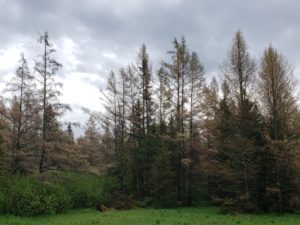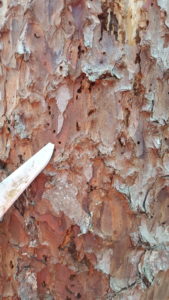By Linda Williams, forest health specialist, Woodruff, Linda.Williams@wisconsin.gov, 920-360-0665
Tamarack trees are sending out their needles this spring, and larch casebearer caterpillars are feeding on them. In northern Wisconsin, where the trees didn’t push needles out until the end of May, the caterpillars were impatiently waiting to begin feeding and in some counties the damage is now severe.

Tamarack trees defoliated by larch casebearer will appear straw-colored or tan from a distance. Photo taken May 28 in Oneida County.
Larch casebearers defoliate tamarack trees early in the season, causing them to look pale green or straw yellow or even brown in cases of severe defoliation. To look for larch casebearers, you’ll need to get close to the tamarack and look for small, cigar-shaped, tan objects attached to the needles. The caterpillars mine out the needles of tamarack and use them as “cases” to protect themselves. If you look closely, you might see tiny head and legs sticking out of one end.

Eastern larch beetle creates round exit holes after it is done feeding under the bark of tamarack trees.
Larch casebearer caterpillars overwinter as young caterpillars and start feeding as soon as the weather warms up in the spring. They pupate on the tree in early summer and then adult moths emerge, mate and lay eggs. Those eggs hatch and additional defoliation in late summer might be noticed as the tiny caterpillars do some feeding to prepare themselves for winter. Repeated defoliation can weaken the tree, making it more susceptible to attack by eastern larch beetle that feeds beneath the bark of larch trees.
Eastern larch beetle is a native bark beetle and although historically this insect has had periodic outbreaks, we have seen damage in Wisconsin every year since 1999. Prolonged annual flooding from 2017-2019 has put many tamarack stands under stress since even tamarack can’t grow in standing water. Eastern larch beetles initially attack stressed tamarack, but once in a stand they often move through it within a few years, steadily continuing to attack trees. Infested stands should be salvage-harvested and regenerated when possible, although given the difficulty of accessing many tamarack stands this can be a challenge.
